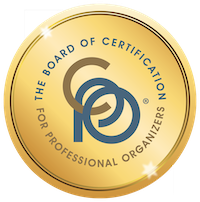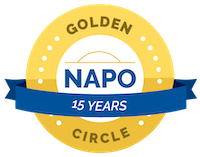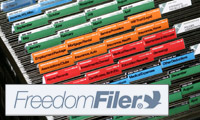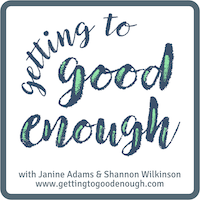New Organizing Guide on creating a successful organizing business

In 2010, I starting publishing my Organizing Guides, my concise downloadable pdfs containing bits of wisdom on various organizing topics.
Today, I added a new Organizing Guide to the collection, bringing the total up to nine. It’s called Living the dream: 10 ingredients for a successful organizing business. My blog post on becoming a professional organizer outlines strategies for getting started. My new guide outlines the essential elements I’ve identified for creating and maintaining success as an organizer.
If you’re an aspiring professional organizer (or if you’re already working as one) and are curious about what qualities I attribute my business success to, please check it out.
All my Organizing Guides are $9 each. This one is six pages long. Click here to purchase it!
Working during times of stress

Since my schedule lightened up a couple of years ago, I’ve lived with relatively little stress. I work hard, which is occasionally stressful, but it’s good stress, since I love my clients and my work. Everything else has been on a pretty even keel. I know that I’m very fortunate.
But this month I’m facing some pretty serious health concerns for loved ones. And this morning my beloved standard poodle, Kirby, woke up not feeling well. We have a vet appointment this afternoon. (That’s him in the photo, on our friend’s porch.)
The worry is driving me to distraction. I know I can’t spend my time worrying because (a) it does no good and (b) I have stuff that needs to get done.
So I got to thinking about what I can do for myself to help me be productive, rather than just miserable, during these times of stress. Here’s what I came up with—maybe it will help you when you’re feeling stressed.
- Stick with my habits and make sure the basics get done. Luckily, my habits are pretty ingrained, so they’re getting done. Ignoring the laundry will get me nowhere, so there are clothes in the wash as I type. Letting my blog go unwritten is also not helpful, so here I am blogging.
- Have a good task list. A solid, realistic daily task list gives structure to my day and helps me know what to do next. (These days, I’m using TeuxDeux to keep track of tasks.)
- Know what’s important. I’m focusing on putting items on my task list that are both urgent and important. Now is probably not the time for me to launch new initiatives.
- Write everything down. My memory isn’t great anyway, but when I’m stressed out it’s really bad. I don’t want to worry about forgetting something, so I’m writing things down, primarily in Evernote (except tasks, which are going in TeuxDeux).
- Distract myself with some fun stuff. I’m trying to keep my daily task list short, leaving me some time to immerse myself in enjoyable, productive endeavors, like knitting, reading or genealogy research.
- Avoid mindless internet or channel surfing. It’s so easy to get on Facebook and lose a half hour (or more) watching dumb videos. That can be mercifully mind-numbing, but also completely unproductive. I’m trying to avoid that by consulting my task list and staying away from Facebook. But I do allow myself the occasional Facebook break—which I keep in check with the help of a timer.
- Practice self care. I’m always urging my clients to take care of themselves and not put everyone else’s needs before their own. That’s something that’s important for me to remember right now.
If all goes well, the majority of the health concerns should be over in about six weeks (shorter for Kirby, I hope!), so this is short term. I can’t put my life and work on hold for six weeks but I can practice the above coping mechanisms.
Making my bed
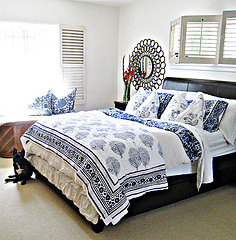
This isn't my bed
I hope I don’t shock you when I share with you that, until recently, I never made my bed. Here’s why: My husband typically gets up after me, so by the time he was up and around my day had begun and I didn’t give my bed another thought. (And he’s not into making the bed.) At bedtime, I’d pull the sheets and blanket up so that we could comfortably sleep in it, but throughout the day it was unmade. No big deal. But certainly not beautiful.
A couple of months ago, I read this post, Former Navy SEAL and I Agree on a Important Habit. Not What You’d Expect, on Gretchen Rubin’s blog and it inspired me to start making the bed. I decided I’d do it when I noticed it unmade. No pressure. Just a little experiment, to see whether it made a difference.
You know what? It does make a difference! When I go into our bedroom throughout the day, for one reason or another, I feel better about the room. When I’m tired and wanting to go to bed, I don’t have to take the time to make it.
I’m not big into lots of pillows and decorative items on the bed (that’s probably obvious), so making it takes just a few moments. It’s a small effort, but it turns out it has a big impact.
Making the bed, for me, is one of those small habits like clearing off my desk each night, and putting my keys in the same place that can make a big difference, especially when it comes automatic.
What small thing do you do regularly that makes your life easier?
Photo © 2010 by Maegan Tintari via Flickr. Used under Creative Commons License
Worth repeating: Decluttering my keys
About ten months ago, I decluttered the copious keys in our house and posted a step-by-step explanation of the process. I’m happy to report that the key bin has not attracted more clutter and we’ve found having labeled keys for our friends’ and neighbors’ homes to be really useful! Here’s that post.
I’m a big believer in having one place where the keys are placed when coming in the door. In our house, it’s been a coated-wire basket just inside the back door, where we enter from the garage. We now automatically drop our keys right in the basket.
The trouble was every key we owned was in that basket, so in order to find the keys I needed on a daily basis, I was having to do a little searching. After a few months of telling myself I needed to do something about it, I finally did.
I thought maybe key hooks would be a good idea for our most frequently used keys, but my husband really likes the ease of just dropping the keys in a container. And who am I to argue with ease?
So here’s how it went, step by step. I was a little surprised that it ended up taking two full hours, but it was time well spent.
Here’s how the key basket looked at the beginning of the two hours:
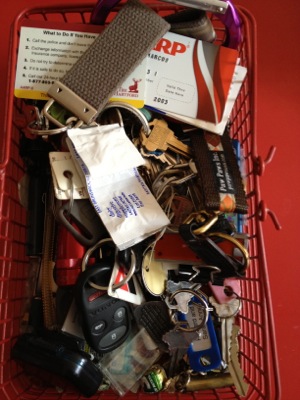
Step One: Empty the container and sort
I emptied the basket and sorting the keys by category. (I discovered lots of non-key items in the key basket as well.) Here’s a photo of the contents of that basket, spread out on my kitchen counter:
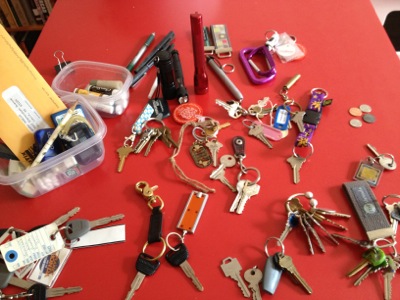
There were five categories of keys:
- House keys (a full set for each of us)
- House keys (a subset, for dog walking)
- Car keys (two cars, each with two keys)
- Keys to friends’ homes
- Keys to a work locations
- Untagged mystery keys
Step Two: Solve some mysteries
I took the mystery keys and tried them on our doors. We have a two-family house, but we live in the whole thing. That means we have two front doors and two back doors. And one of our front doors has two locks, though we only use one of them.
In that process, I was able to identify seven previously unidentified keys to our house:
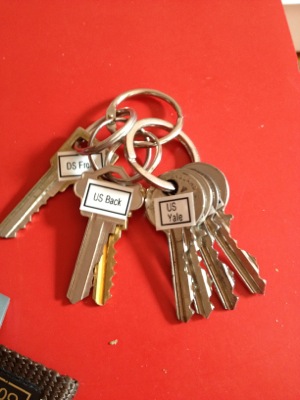
Step Three: Label the keys
I got out my label maker and created labels for all the keys to our friends’ homes and work locations and for the newly identified keys. I didn’t bother to label the keys that are on our daily key rings; we know them by sight.
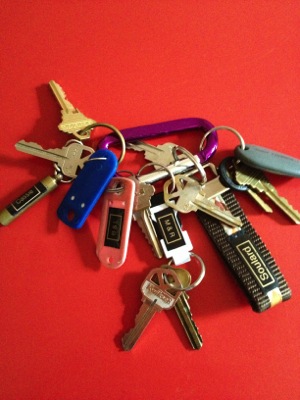
Step Four: Organize the keys in a new container
Barry and I agreed that the wire basket wasn’t great because keys would sometimes get caught in the holes. So I replaced it with a clear plastic drawer organizer I had on hand. Since one of the problems had been that it was hard to find the keys we needed among the many keys in the basket, I decided to place only the first three categories of keys in this new container. (Main key rings, dog-walkings, car keys.)
I put the labeled friends’ keys on a carabiner and the extra keys for our doors on a binder ring. I placed those two bundles in a basket that sits on the shelf next to the key basket. (That basket also holds eye glasses and cases.)
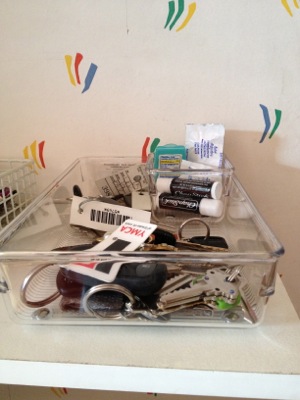
Step Five: Organize a few non-key items in the container
There were a few items in the old key basket that we like to have close at hand when we’re walking out the door. They include lip balm, lactase enzyme tablets and a little magnifier/flashlight that makes menu reading easier, and a small flashlight for nighttime dog walking. So I took a smaller drawer organizer and put into the larger one to isolate most of those items, so they’re not in the way.

Overall, I’m really pleased with how this worked out. It’s not perfectly organized by any stretch of the imagination. But it is organized enough: The keys we need most often are easier to grab and it will be as easy as ever to put them away. Now we can easily identify our friends’ keys when we need them. And if we need an extra set of our own to give someone, they’ll be easy to find.
(I bet you’re wondering what we did with the keys we couldn’t identify. The organizer in me wanted to get rid of them, but my husband was more comfortable keeping them. I put them in a zip-top bag marked “These keys are not for our house” and put them in a drawer in our extra kitchen where I would know to look for them if we were ever looking for keys that someone said they had given us.)
True freedom
It’s Independence Day here in the United States and that got me thinking about what independence means to me.
I decided to create a little graphic to declare what I think brings true freedom.
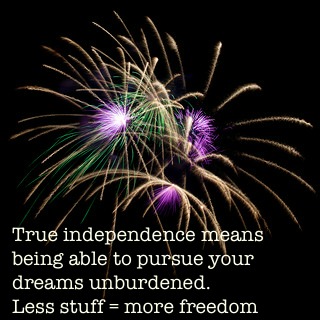
This month marks nine years since I founded Peace of Mind Organizing®. The longer I do this work, the more truth I see in this sentiment.
Photo by Paul Poli via Flickr.
A key to keeping surfaces clear
If you click on the clean bureau tag to left on this blog, you’ll see that pretty much every year one of my goals is to put my clothes away properly at night and keep the top of the bureau clear.
It’s obviously been an ongoing struggle with me. But for the past month of so, I’ve been doing it successfully every day, with minimal effort. And I think I know why.
I cleared off the bureau when I did my jewelry reorganization and now only three things, my jewelry box plus two small lamps, reside there.

Before, when the bureau was cleared off, many items actually lived there so it always looked a bit junky. Add some dirty socks or tags cut off of new clothes or yesterday’s jeans and it didn’t make a gigantic difference.
But now if I’m tempted to leave something on the bureau it sticks out like a sore thumb. So I take the extra ten seconds to either put it away or toss it down the laundry chute or in the trash, which is right next to the dresser.
With the three items anchoring the space, it’s become really easy to keep this space clear. It’s clear to me that the key is limiting the items that legitimately reside on the bureau top. It’s been only a three weeks or so, but I feel very optimistic.
The same holds true for my desk in my office, which I try to clear each night. If I leave a pile of action papers on the corner of the desk (which I tend to do when I’m feeling lazy), the pile soon grows (and little action gets taken). Once that pile grows, I might start leaving small items in the middle of the desk. After a few days of this, I have to take a few minutes to put everything away except the few things that legitimately reside there.
Based on my experience with my bureau, I think it’s time for me to take a hard look at the things I store on my desk and make sure that they deserve that prime real estate. I’d be willing to bet that I can move a few things to the office-supply closet just a few steps from my desk. And that will make it easier to keep up my clear-desk habit.
Worth repeating: We all have fear
I wrote this post five years ago, but it still rings true. Recently, I purchased a greeting card whose front bears this quotation from George Addair: “Everything you want is on the other side of fear.” Distinguishing between when your fear is protecting you and when it’s limiting you can be a tricky thing.
Recently my husband and I went to a family reunion held at a ski resort in Pennsylvania (it was the end of June and there was no snow). He and I rode a chair lift up to the top of the mountain to enjoy the view. I don’t ski and I’ve only been on a ski lift a handful of times. Neither of us heard the mumbling attendant’s instructions to pull the restraining bar over our heads and lock it in place in front of us. So we were riding up the mountain with nothing preventing us from falling out of the moving chair.
Now, the lift was slow and the mountain slope gentle. So we weren’t really in danger. But I Freaked Out. Oh my goodness. I tried to keep from panicking and became quite upset. I should have been reassured by the mountain bikers who were in the seat ahead of us. They weren’t restrained either (and they were holding bikes!). That didn’t help me. I sat there, gripped by fear.
We figured out about the restraining bar when we approached the top and saw a sign about raising the bar. We made sure we were restrained on the ride down. It was much more enjoyable!

My husband, Barry, with his sister, Lori. That's the chair lift in the background. It doesn't look so scary, does it?
Afterward, I realized what an unfamiliar feeling that was. I don’t put myself in a position to be afraid for my physical safety. (So it might not surprise you that I don’t ski. Or skydive. Or race fast cars.) Fear stops me from doing things I consider dangerous. And that’s fine with me.
But fear also stops me from doing other things. In working with my fabulous life coach, Shannon Wilkinson, I’ve learned that I’m driven by a craving for peace and harmony. I’m afraid to do anything that might disrupt it. That’s why I put off tasks that seem like they might be difficult or stressful (which of course makes them more stressful, usually). That’s why I’ll avoid discussions that might be contentious, even if there’s stuff that needs to be discussed.
Sometimes it’s for good—my fear of disharmony does allow me to avoid unpleasantness. But sometimes unpleasantness can’t be avoided and all my fear does is put it off. That’s rarely for the best.
The strange thing is that there are things I’m not afraid of that make other people shake in their boots. Like public speaking. Or starting a new business. Or writing for publication. And I’ll actually fly as a passenger in a glider, since that’s my husband’s hobby.
As I’ve written about before, sometimes decluttering can be really scary. You might be afraid of what you’ll find. Or you might even fear what you’ll do with yourself once clutter stops being a barrier to living. In our e-course, Declutter Happy Hour, Shannon (the aforementioned life coach) and I address head-on the emotions behind the clutter. If your clutter is a scary thing, it just might help.
We all have fears. We can try to live without fear by avoiding anything scary. Or we can try to recognize our fears, face them and get past them when it benefits us. Fear can stop us from doing stupid things. It can also stop us from doing smart things. For me, the key is learning to tell the difference.
Search
Recent Posts
- Budgeting and decluttering: It's all about priorities
- Today's truth bomb
- Worth repeating: Labels in the refrigerator
- The meat of my Bullet Journal
- Worth repeating (again): Getting past "I might need it some day"
- Furthering your goals one tiny step at a time
- Repeating spreads in my Bullet Journal
Tags
Links
- Ravelry
- Peace of Mind Spending
- Are you interested in becoming a professional organizer?
- NAPO St. Louis
- Getting to Good Enough podcast
- Institute for Challenging Disorganization
- Organize Your Family History
- National Association of Productivity and Organizing Professionals
- Shannon Wilkinson, life coach


